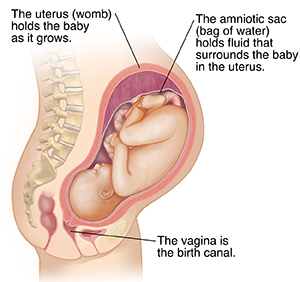What Is Group B Strep?
Group B strep (streptococcus) is a common type of bacteria. It can grow in the vagina, rectum, or urinary tract. It most often does not cause harm in adults. But in rare cases, a pregnant person who has group B strep can infect the baby during birth. This can cause serious illness in the newborn. But treatment during labor reduces the risk of the baby becoming infected. And if a newborn gets group B strep, the infection can be treated.

Facts about group B strep
Learning more about group B strep can help you understand how testing and treatment can help. Here are some basic facts about group B strep:
-
It's not a sexually transmitted infection.
-
It's not the same as strep throat. (That is caused by group A strep.)
-
It often has no symptoms. It may cause no problems in adults.
-
Test results can be misleading. They may be negative one week and positive the next week.
-
Group B strep can be spread to the baby during vaginal delivery. It can't be passed during cesarean (surgical) birth.
-
A person with group B strep rarely infects the newborn. (Infection happens only about 1% to 2% of the time.)
-
When a person is treated during labor and delivery, the baby almost never becomes infected.
-
Certain factors during pregnancy increase the risk of a baby becoming infected.
Possible effects on your baby
Group B strep can infect the blood. It can also cause inflammation of the baby’s lungs, brain, or spinal cord. Long-term effects can include blindness, deafness, mental retardation, or cerebral palsy. And in rare cases, infection causes death. Infection is most often found soon after the baby is born.
How your baby may become infected
Group B strep often lives in the vagina or rectum. If the amniotic sac breaks early, bacteria from the vagina can travel to the uterus, reaching the baby. Or, while passing through the birth canal, the baby can come in contact with the bacteria. In rare cases, group B strep can be passed to the baby after delivery. This is called late-onset group B strep. The source of this type of infection is not well-understood. But some experts believe that it happens if the baby is exposed to group B strep in the home, from the parents or siblings, or in the community.
What increases the risk?
Certain things increase the chance that a baby will be infected. They include:
-
Breaking or leaking of the amniotic sac before 37 weeks of pregnancy
-
Labor before 37 weeks of pregnancy
-
Breaking of the amniotic sac more than 18 hours before labor starts
-
Fever during labor
-
A urinary tract infection with group B strep at any point in the pregnancy
-
Having a previous baby born with a group B strep infection
Online Medical Reviewer:
Donna Freeborn PhD CNM FNP
Online Medical Reviewer:
Heather M Trevino BSN RNC
Online Medical Reviewer:
Irina Burd MD PhD
Date Last Reviewed:
6/1/2022
© 2000-2025 The StayWell Company, LLC. All rights reserved. This information is not intended as a substitute for professional medical care. Always follow your healthcare professional's instructions.